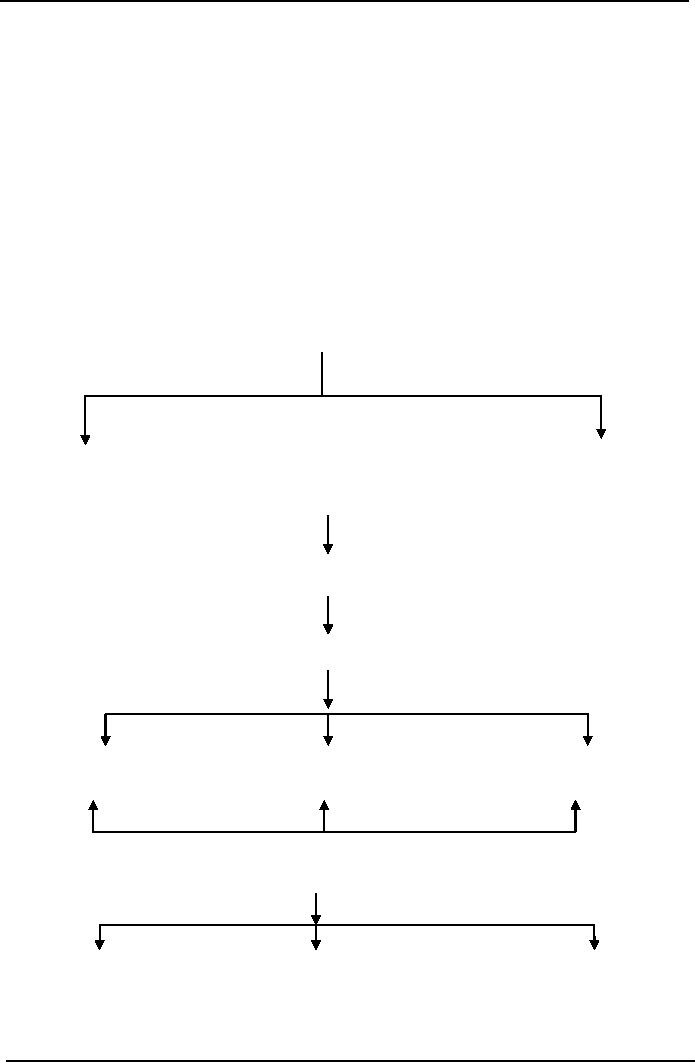 |
WHAT IS A BUDGET?:Budgetary control, Making a Forecast, Preparing budgets |
| << BREAKEVEN ANALYSIS – CHARTS AND GRAPHS:Usefulness of charts |
| Production & Sales Budget:Rolling budget, Sales budget >> |

Cost
& Management Accounting
(MGT-402)
VU
LESSON-33
WHAT
IS A BUDGET?
A budget is a
plan expressed in quantitative,
usually monetary terms, covering a
specific period of
time,
usually one year. In other
words, a budget is a systematic plan
for the utilization
of
manpower
and material resources. In a business
organization a budget represents an
estimate of
future
costs and revenues. Budgets
may be divided into two
basic classes; Capital
Budgets and
Operating
Budgets, Capital budgets are
directed towards proposed expenditures
for new projects
and
often require special financing
(this topic is discussed in
the next Unit). The
operating budgets
are
directed towards achieving short-term operational
goals of the organization,
for instance,
production
or profit goals in a business
firm. Operating budgets may
be sub-divided into various
departmental
or functional budgets. The
main characteristics of a budget
are:
It
is prepared in advance and is derived
from the long, term
strategy of the
organization.
It
relates to future period for
which objectives or goals have
already been laid
down.
It
is expressed in quantitative form,
physical or monetary units, or
both.
Different
types of budgets are
prepared for different
purposes e.g. Sales. Budget,
Production
Budget.
Administrative Expense Budget, Raw
material Budget, etc. All these
sectional budgets are
afterwards
integrated into a master budget- which
represents an overall plan of
the organization. A
budget
helps us in the following
ways:
1.
It brings about efficiency and
improvement in the working of
the organization.
2.
It is a way of communicating the plans to
various units of the organization. By
establishing
the
divisional, departmental, sectional
budgets, exact responsibilities
are assigned. It thus
minimizes
the possibilities of buck-passing if
the budget figures are not
met.
3.
It is a way or motivating managers to
achieve the goals set
for the units.
4.
It serves as a benchmark for
controlling on going. Operations.
5.
It helps in developing a team spirit
where participation in budgeting is
encouraged.
6.
It helps in reducing wastage's and
losses by revealing them in time
for corrective action.
7.
It serves as a basis for evaluating
the performance of
managers.
8.
It serves as a means of educating
the managers.
Budgetary
control
No
system .of planning can be
successful without having an
effective and efficient
system of
control.
Budgeting is closely connected with control.
The exercise of control in
the organization
with
the help of budgets is known
as budgetary control. The process of
budgetary control includes
(i)
preparation of various budgets (ii)
continuous comparison of actual
performance with budgetary
performance
and (iii) revision of
budgets in the light of
changed circumstances.
A
system of budgetary control should
not become rigid. There
should be enough scope
for
flexibility
to provide for individual
initiative and drive. Budgetary
control is an important device
for
making
the organization more
efficient on all fronts. It is an
important tool for
controlling costs
and
achieving the overall objectives.
Installing
a budgetary control system
Having
understood the meaning and
significance of budgetary control in an
organization, it will be
useful
for you to know how a
budgetary control system can be installed
in the organization.
This
requires,
first of all, finding
answers to the following
questions in the context of an
organization:
201

Cost
& Management Accounting
(MGT-402)
VU
What
is likely to happen?
What
can be made to
happen?
What
are the objectives to be
achieved?
What
are the constraints and to
what extent their effects
can be minimized?
Having
found answers to the above
questions, the following
steps may be taken for
installing an
effective
system of budgetary control in an
organization.
Organization
for budgeting
The
setting up of a definite plan of
organization is the first
step towards installing budgetary
control
system in an organization. A Budget
Manual should, be prepared
giving details of the
powers,
duties, responsibilities and
areas of operation of each executive in
the organization.
Responsibility
for budgeting
The
responsibility for preparation and
implementation of the budgets
may be fixed as
under:
Budget
controller
Although
the Chief Executive is
finally responsible for the
budget programme, it is better if a
large
part
of the supervisory responsibility is
delegated to an official designated as
Budget Controller or
Budget
Director. Such a person should
have knowledge of the technical details
of the business and
should
report directly to the
President or the Chief
Executive of the
organization.
Budget
committee
The
Budget Controller is assisted 'in his
work by the Budget Committee. The
Committee may
consist
of Heads of various departments, viz.,
Production, Sales. Finance Personnel,
Purchase, etc.
with
the Budget Controller as its Chairman. It is generally
the responsibility of the.
Budget
Committee
to submit discusses and
finally approves the budget figures. Each
head of the
department
should have his own Sub-committee
with executives working
under him as its
members.
Fixation
of the Budget Period
Budget
period' means the period for
which a budget is prepared and employed.
The budget period
depends
upon the nature of the
business and the control
techniques. For example, a
seasonal
industry
will budget for each season,
while an industry requiring
long periods to complete
work
will
budget for four, five or
even larger number, of
years. However, it is necessary
for control
purposes
to prepare budgets both for
long as well as short
periods.
Budget
procedures
Having
established the budget organization
and fixed the budget period,
the actual work or
budgetary
control can be taken upon
the following
pattern:
Key
factor
It
is also termed as limiting factor.
The extent of influence of
this factor must first be
assessed in
order
to ensure that the budget
targets are met It would be
desirable to prepare first
the budget
relating
to this particular factor,
and then prepare the
other budgets. We are giving
below an
illustrative
list of key factors in certain
industries.
202

Cost
& Management Accounting
(MGT-402)
VU
Industry
Key
factor
Motor
Car
Sales
demand
Aluminum
Power
Petroleum
Refinery
Supply
of crude oil
Electro-optics
Skilled
technicians
Hydral
Power generation
Monsoon
The
key factors should be
correctly identified and
examined. The key factors
need not be a
permanent
nature. In the long run,
the management may overcome
the key factors by
introducing
new
products, by changing material mix or by
working overtime or extra shifts
etc.
Making
a Forecast
A
forecast is an estimate of the
future financial conditions or operating
results. Any estimation is
based
on consideration of probabilities. An estimate differs
from a budget in that the
latter
embodies
an operating plan or an organization. A budget
envisages a commitment to certain
objectives
or targets, which the
management seeks to attain on the
basis of the forecasts
prepared.
A
forecast on the other hand
is an estimate based on probabilities of an
event. A forecast may
be
prepared
in financial or physical terms for sales,
production cost, or other
resources required for
business.
Instead of just one forecast a
number of alternative forecasts may be
considered with a
view
to obtaining the most
realistic overall
plan.
Preparing
budgets
After
the forecasts have been
finalized the preparation of budgets
follows. The budget
activity
starts
with the preparation of the
said budget. Then, production budget is
prepared on the basis
of
sales
budget and the production
capacity available. Financial budget
(i.e. cash or working
capital
budget)
will be prepared on the
basis of sale forecast and
production budget. All these
budgets are
combined
and coordinated into -a master budget-
The budgets may be revised
in the course of the
financial
period if it becomes necessary to do so in
view of the unexpected developments,
which
have
already taken place or are
likely to take place.
Choice
between Fixed and Flexible
Budgets
A
budget may be fixed or flexible. A
fixed budget is based on a fixed
volume of activity, 11
may
lose
its effectiveness in planning and
controlling if the actual
capacity utilization is different
from
what
was planned for any particular
unit of time e.g. a month or
a quarter. The flexible budget
is
more
useful for changing levels of
activity, as it considers fixed
and variable costs
separately. Fixed
costs,
as you are aware, remain unchanged
over a certain range of output such
costs change when
there
is a change in capacity level.
The variable costs change in
direct proportion to output if
flexible
budgeting approach is adopted, the budget
controller can analyze the
variance between
actual
costs and budgeted costs
depending upon the actual
level of activity attained
during a period
of
time.
203

Cost
& Management Accounting
(MGT-402)
VU
Objective
of Budget
Profit
maximization.
Maximization
of sales.
Volume
growth.
To
compete with the
competitors.
Development
of new areas of operation.
Quality
of service.
Work-force
efficiency.
Divisions
of Budget
Division
of Budgets
Functional
Budget
Master
Budget
Functional
Budget
Sales
Budget
Production
Budget
Raw
material
Labor
Factory
overhead
Cost
of goods
sold
Selling
&
General
&
Financial
distribution
Administrative
charges
expenses
expenses
budget
budget
budget
204
Table of Contents:
- COST CLASSIFICATION AND COST BEHAVIOR INTRODUCTION:COST CLASSIFICATION,
- IMPORTANT TERMINOLOGIES:Cost Center, Profit Centre, Differential Cost or Incremental cost
- FINANCIAL STATEMENTS:Inventory, Direct Material Consumed, Total Factory Cost
- FINANCIAL STATEMENTS:Adjustment in the Entire Production, Adjustment in the Income Statement
- PROBLEMS IN PREPARATION OF FINANCIAL STATEMENTS:Gross Profit Margin Rate, Net Profit Ratio
- MORE ABOUT PREPARATION OF FINANCIAL STATEMENTS:Conversion Cost
- MATERIAL:Inventory, Perpetual Inventory System, Weighted Average Method (W.Avg)
- CONTROL OVER MATERIAL:Order Level, Maximum Stock Level, Danger Level
- ECONOMIC ORDERING QUANTITY:EOQ Graph, PROBLEMS
- ACCOUNTING FOR LOSSES:Spoiled output, Accounting treatment, Inventory Turnover Ratio
- LABOR:Direct Labor Cost, Mechanical Methods, MAKING PAYMENTS TO EMPLOYEES
- PAYROLL AND INCENTIVES:Systems of Wages, Premium Plans
- PIECE RATE BASE PREMIUM PLANS:Suitability of Piece Rate System, GROUP BONUS SYSTEMS
- LABOR TURNOVER AND LABOR EFFICIENCY RATIOS & FACTORY OVERHEAD COST
- ALLOCATION AND APPORTIONMENT OF FOH COST
- FACTORY OVERHEAD COST:Marketing, Research and development
- FACTORY OVERHEAD COST:Spending Variance, Capacity/Volume Variance
- JOB ORDER COSTING SYSTEM:Direct Materials, Direct Labor, Factory Overhead
- PROCESS COSTING SYSTEM:Data Collection, Cost of Completed Output
- PROCESS COSTING SYSTEM:Cost of Production Report, Quantity Schedule
- PROCESS COSTING SYSTEM:Normal Loss at the End of Process
- PROCESS COSTING SYSTEM:PRACTICE QUESTION
- PROCESS COSTING SYSTEM:Partially-processed units, Equivalent units
- PROCESS COSTING SYSTEM:Weighted average method, Cost of Production Report
- COSTING/VALUATION OF JOINT AND BY PRODUCTS:Accounting for joint products
- COSTING/VALUATION OF JOINT AND BY PRODUCTS:Problems of common costs
- MARGINAL AND ABSORPTION COSTING:Contribution Margin, Marginal cost per unit
- MARGINAL AND ABSORPTION COSTING:Contribution and profit
- COST – VOLUME – PROFIT ANALYSIS:Contribution Margin Approach & CVP Analysis
- COST – VOLUME – PROFIT ANALYSIS:Target Contribution Margin
- BREAK EVEN ANALYSIS – MARGIN OF SAFETY:Margin of Safety (MOS), Using Budget profit
- BREAKEVEN ANALYSIS – CHARTS AND GRAPHS:Usefulness of charts
- WHAT IS A BUDGET?:Budgetary control, Making a Forecast, Preparing budgets
- Production & Sales Budget:Rolling budget, Sales budget
- Production & Sales Budget:Illustration 1, Production budget
- FLEXIBLE BUDGET:Capacity and volume, Theoretical Capacity
- FLEXIBLE BUDGET:ANALYSIS OF COST BEHAVIOR, Fixed Expenses
- TYPES OF BUDGET:Format of Cash Budget,
- Complex Cash Budget & Flexible Budget:Comparing actual with original budget
- FLEXIBLE & ZERO BASE BUDGETING:Efficiency Ratio, Performance budgeting
- DECISION MAKING IN MANAGEMENT ACCOUNTING:Spare capacity costs, Sunk cost
- DECISION MAKING:Size of fund, Income statement
- DECISION MAKING:Avoidable Costs, Non-Relevant Variable Costs, Absorbed Overhead
- DECISION MAKING CHOICE OF PRODUCT (PRODUCT MIX) DECISIONS
- DECISION MAKING CHOICE OF PRODUCT (PRODUCT MIX) DECISIONS:MAKE OR BUY DECISIONS